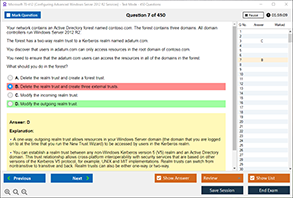Overview of the CompTIA SY0-701 Exam
The CompTIA SY0-701 exam, also known as Security+ (SY0-701), is a globally recognized certification that validates a candidate’s foundational knowledge in cybersecurity. It covers essential domains such as:
-
Threats, attacks, and vulnerabilities
-
Security architecture and design
-
Implementation of security measures
-
Incident response
-
Risk management
The SY0-701 version emphasizes current trends in cybersecurity, including network-based attacks, cloud security, and identity management. Understanding protocols like ARP and how they can be exploited is a fundamental skill tested in the exam.
DumpsBoss is a go-to platform for SY0-701 practice questions and exam preparation materials, enabling learners to reinforce their theoretical knowledge with real-world scenarios and practical insights.
Definition of ARP (Address Resolution Protocol)
The Address Resolution Protocol (ARP) is a crucial protocol in the TCP/IP suite used to map IP addresses to MAC (Media Access Control) addresses within a local area network (LAN). When a device on a network needs to communicate with another, it must resolve the IP address to the physical MAC address.
Here’s a simplified explanation of how ARP works:
-
Device A wants to send data to Device B on the same network.
-
Device A checks its ARP cache for Device B’s MAC address.
-
If not found, Device A sends a broadcast ARP request: “Who has IP address X.X.X.X?”
-
Device B replies with its MAC address.
-
Device A updates its ARP table and sends the data to Device B.
This protocol facilitates seamless communication within networks but is inherently vulnerable due to its trust-based design, which is where ARP poisoning comes into play.
Passive ARP Poisoning Attack
A passive ARP poisoning attack is a form of Man-in-the-Middle (MitM) attack where the attacker silently intercepts traffic between two devices without altering the data. The attacker sends fake ARP responses to update the victim’s ARP table with the wrong MAC address. As a result, the victim unknowingly routes traffic through the attacker.
How It Works:
-
The attacker listens to ARP traffic on the network.
-
The attacker sends forged ARP replies associating their MAC address with the IP of a trusted device (e.g., a router or server).
-
The victim updates its ARP cache, believing the attacker’s MAC address is the correct destination.
-
All traffic intended for the original device is now forwarded to the attacker.
-
The attacker passively observes the traffic without modifying it.
Passive ARP poisoning is stealthy and hard to detect, making it especially dangerous in sensitive network environments.
Result of a Passive ARP Poisoning Attack
The consequences of a passive ARP poisoning attack can be severe, especially in environments that rely on confidentiality and data integrity.
Key Impacts:
-
Data Interception: The attacker can capture sensitive information, including credentials, emails, and financial data.
-
Traffic Monitoring: Continuous traffic analysis enables attackers to build user profiles, detect system vulnerabilities, or gather intelligence.
-
Credential Harvesting: By observing login sessions or authentication handshakes, attackers may extract usernames and passwords.
-
Unauthorized Access: Intercepted session tokens can allow the attacker to hijack user sessions.
-
Loss of Privacy: The integrity of user data is compromised, posing risks in personal and professional settings.
For anyone preparing for the SY0-701 exam, understanding these results is essential not just for passing the test but also for applying knowledge to real-world scenarios.
Comparison: Passive vs. Active ARP Poisoning
Both passive and active ARP poisoning aim to manipulate the ARP cache, but they differ in intent, visibility, and impact.
| Aspect | Passive ARP Poisoning | Active ARP Poisoning |
|---|---|---|
| Goal | Eavesdropping and surveillance | Disruption or redirection of traffic |
| Visibility | Stealthy and hard to detect | Often easier to detect due to network anomalies |
| Impact | Data is intercepted silently | Data can be altered, redirected, or dropped |
| Usage | Intelligence gathering | Denial of service, redirection to malicious sites |
| Detection Difficulty | High | Moderate to High |
| Examples | Capturing credentials, user behavior | Redirecting users to phishing sites, causing outages |
In the SY0-701 exam, understanding this comparison is crucial, as questions often ask candidates to differentiate between various attack types based on intent and method.
Preventing ARP Poisoning
Mitigating ARP poisoning attacks requires a multi-layered security approach. Here are effective strategies and tools to combat ARP spoofing:
1. Static ARP Entries
Manually assigning IP-to-MAC address mappings can prevent spoofing but is only practical in small networks due to scalability issues.
2. Packet Filtering
Firewalls and intrusion detection systems (IDS) can inspect ARP packets and block suspicious behavior.
3. Dynamic ARP Inspection (DAI)
Available in enterprise switches (e.g., Cisco), DAI checks ARP packets against a trusted database and discards invalid entries.
4. Encryption
Using encrypted communication protocols like HTTPS, SSH, and VPN ensures that even if traffic is intercepted, it remains unreadable.
5. Network Segmentation
Isolating critical devices on separate VLANs minimizes the attack surface for ARP spoofing.
6. ARP Monitoring Tools
Tools such as XArp, Ettercap, and Wireshark can detect ARP anomalies and raise alerts for network administrators.
7. User Training
Educating users about phishing links, certificate warnings, and best practices helps reduce the impact of MitM attacks.
For candidates preparing for the SY0-701 certification, DumpsBoss offers targeted practice questions that reinforce these countermeasures and help you recall them efficiently during the exam.
Relevance to SY0-701 Exam
ARP poisoning and other network attacks fall under the “Threats, Attacks, and Vulnerabilities” domain in the SY0-701 exam. Candidates are expected to understand:
-
How ARP works
-
The differences between passive and active poisoning
-
The consequences of these attacks
-
Detection and prevention techniques
Here’s why ARP poisoning is a high-yield topic:
-
Scenario-based questions often describe symptoms (e.g., slow traffic, unauthorized access) that relate to MitM attacks.
-
Multiple-choice questions may ask about identifying or mitigating ARP-based threats.
-
Performance-based questions (PBQs) may simulate network environments where you must detect or block ARP attacks.
By studying real-world examples and applying DumpsBoss’ comprehensive exam prep tools, candidates can gain an edge in mastering these concepts.
Why Choose DumpsBoss for Your SY0-701 Preparation?
DumpsBoss is a trusted name for IT certification exam preparation, offering:
-
Accurate and up-to-date exam dumps tailored to the latest SY0-701 syllabus.
-
Scenario-based practice questions that mirror actual exam difficulty.
-
Detailed explanations to help you understand the “why” behind each answer.
-
Accessible formats—PDFs, interactive online platforms, and mobile-friendly interfaces.
Whether you're a student, entry-level security analyst, or transitioning IT professional, DumpsBoss can accelerate your success in passing the SY0-701 exam on the first try.
Conclusion
ARP is a fundamental protocol that enables seamless network communication—but its vulnerabilities can open doors to serious cybersecurity risks like passive ARP poisoning. Understanding how these attacks occur, what damage they can cause, and how to prevent them is not only vital in protecting real-world systems but also in passing the CompTIA SY0-701 exam.
By studying concepts such as passive vs. active ARP poisoning and implementing preventative measures, you’ll be well-equipped to handle questions in the SY0-701 exam. DumpsBoss serves as your expert partner in this journey, providing reliable exam materials, mock tests, and insider tips to help you excel.
Ready to level up your cybersecurity career? Start your journey today with DumpsBoss and ace the SY0-701 exam with confidence!
Special Discount: Offer Valid For Limited Time “CompTIA SY0-701 Dumps” Order Now!
Sample Questions for CompTIA SY0-701 Exam Dumps
Actual exam question from CompTIA SY0-701 Exam.
What is the result of a passive ARP poisoning attack?
A) Data is modified in transit
B) Network traffic is blocked entirely
C) Sensitive data is silently intercepted
D) The victim's device is shut down



